14. - 29.3.2008
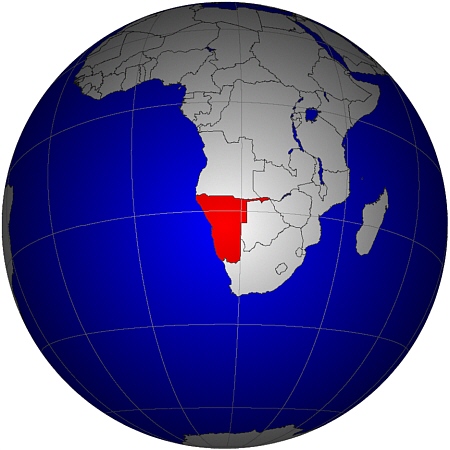
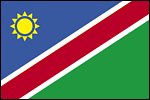 The vacation period moved closer and thus also the search for an interesting target.
This time I had an area in mind that has to offer at first sight only deserts and steppes: Namibia, located on the southwest coast of Africa.
But if you look more precise, it's turned out not everywhere like that.
The further one comes to the north, the plant and animal life become manifoldly.
The vacation period moved closer and thus also the search for an interesting target.
This time I had an area in mind that has to offer at first sight only deserts and steppes: Namibia, located on the southwest coast of Africa.
But if you look more precise, it's turned out not everywhere like that.
The further one comes to the north, the plant and animal life become manifoldly.
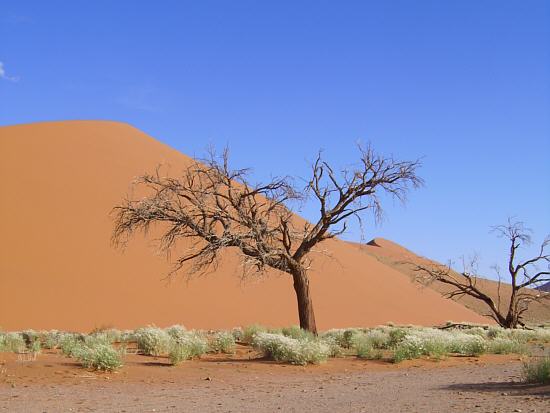 But above all the dunes pulled me there. And I wanted to see even once, how people live in such arid region.
In addition still another fact excited my interest.
On an area, which is 2.5 times larger than Germany, live only 2 million people (in Germany 80 million).
And from those are only about 100 radio amateurs (in Germany about 78200). Thus ideal conditions for me as a tourist and as a radio amateur. (Photo: dunes near Sossusvlei)
But above all the dunes pulled me there. And I wanted to see even once, how people live in such arid region.
In addition still another fact excited my interest.
On an area, which is 2.5 times larger than Germany, live only 2 million people (in Germany 80 million).
And from those are only about 100 radio amateurs (in Germany about 78200). Thus ideal conditions for me as a tourist and as a radio amateur. (Photo: dunes near Sossusvlei)
Stages of the journey
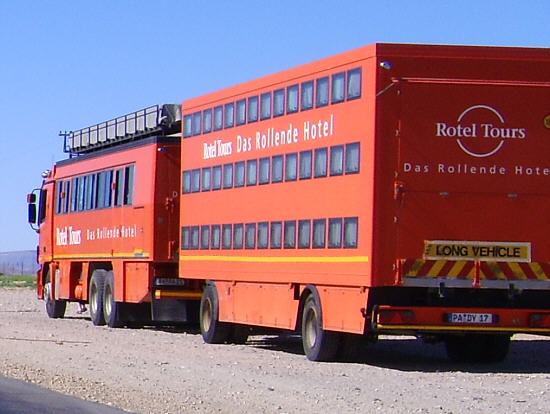 In Namibia it gives some railroad lines and also some bus lines, but for the last 10 to 50 km to the attractions a car is necessary.
Since I possess however still no driving licence, I opt again for Rotel Tours as organizer.
With them one travels with a bus plus a sleeping car.
The route planned by them leads on a round distance both into the sandily south and into the green north. (Photo: 34-seater with trailer)
In Namibia it gives some railroad lines and also some bus lines, but for the last 10 to 50 km to the attractions a car is necessary.
Since I possess however still no driving licence, I opt again for Rotel Tours as organizer.
With them one travels with a bus plus a sleeping car.
The route planned by them leads on a round distance both into the sandily south and into the green north. (Photo: 34-seater with trailer)
Day 1: in the evening departure from Munich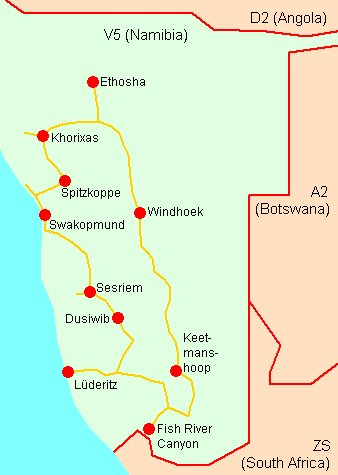
Day 2: in the morning arrival in Windhoek, Keetmanshoop
Day 3: Fish River Canyon
Day 4: Lüderitz
Day 5: Dusiwib
Day 6: Sesriem
Day 7 - 8: Swakopmund
Day 9: Spitzkoppe
Day 10 - 11: Khorixas
Day 12 - 13: Ethosha National Park
Day 14 - 15: Windhoek
Day 16: in the early morning flight to Munich
Guest license ![]()
Namibia is not a CEPT country. But the information from OH2MCM to the acquisition of a transmission license for Namibia has been very promising.
So I've been decided to take along also my QRP station.
A suitable application form I found at the webpages of the Namibia Communications Commission (NCC).
If you should have any questions to the license, then the Namibian Amateur Radio League (NARL) gives fast competently answer.
With me it took straight once 48 hours for request on a very special question in the application form and despite a further inquiry with the NCC for their part.
Trusty Tailor, V51TT, is as a secretary of the NARL a really good contact person!
But in the two months before the departure neither arrived a feedback of the NCC with me nor with my contact address in Namibia.
Therefore I did not pack I my radio station also in the luggage.
There is enough asking with a radio station and the necessary cable/wires by an air passage, so that I also did not want to be in trouble which because of a missing license.
When I was back in Germany, I found to my astonishment a message of Mr. Johan Schutte from the NCC in my mailbox and on my answering mashine.
He communicated to me two days after my takeoff to Namibia that the guest license would lie ready for the collection in his office by the NCC.
Oh well, there I had tough luck.
The station did still lie at home and I knew anything from the issued license.
But from errors one becomes as well known intelligent.
With next time I will at least again inquire, as the state of affairs.
Travel experiences ![]()
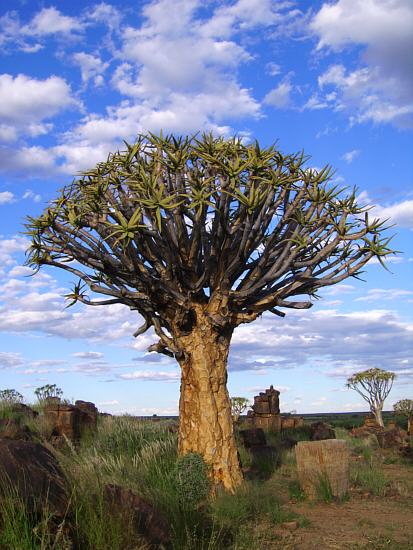 In the early morning at the day 2 we arrived after a night flight of approximately 10 hours at Windhoek.
From there we drove with Katrin Haas as tourist guide, Anton (Tony) Schändlinger as driver and the rolling hotel immediately to Keetmanshoop.
This was a quite long distance by savannahs and steppes, which was interrupted however by various stops and the attendance of an area with many quiver trees close to Keetmanshoop.
This are actually no trees, but they rank among the aloes.
The area visited by us calls itself Giant's Playground.
It offers in addition innumerable granite blocks beside the trees, which look as one on the other set by giants.
By the way one calls this erosion form woollen-sack granite, as Katrin sayed.
In the early morning at the day 2 we arrived after a night flight of approximately 10 hours at Windhoek.
From there we drove with Katrin Haas as tourist guide, Anton (Tony) Schändlinger as driver and the rolling hotel immediately to Keetmanshoop.
This was a quite long distance by savannahs and steppes, which was interrupted however by various stops and the attendance of an area with many quiver trees close to Keetmanshoop.
This are actually no trees, but they rank among the aloes.
The area visited by us calls itself Giant's Playground.
It offers in addition innumerable granite blocks beside the trees, which look as one on the other set by giants.
By the way one calls this erosion form woollen-sack granite, as Katrin sayed.
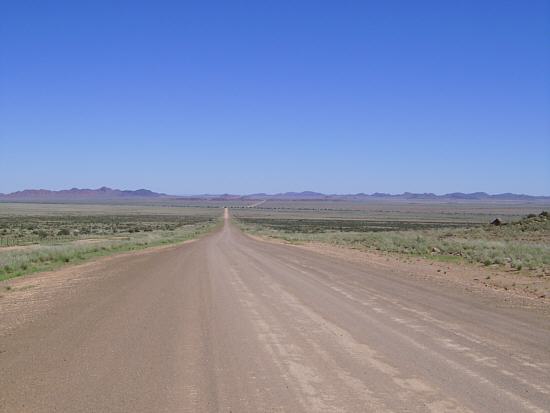 Only at the day 3 I became aware so correctly the hugeness of Namibia.
Between the small localities lie in often 100 km and more with dead straight pistes (pads) between.
Only some few are tarred, the remaining consist of packed containing granite rubble.
Only at the day 3 I became aware so correctly the hugeness of Namibia.
Between the small localities lie in often 100 km and more with dead straight pistes (pads) between.
Only some few are tarred, the remaining consist of packed containing granite rubble.
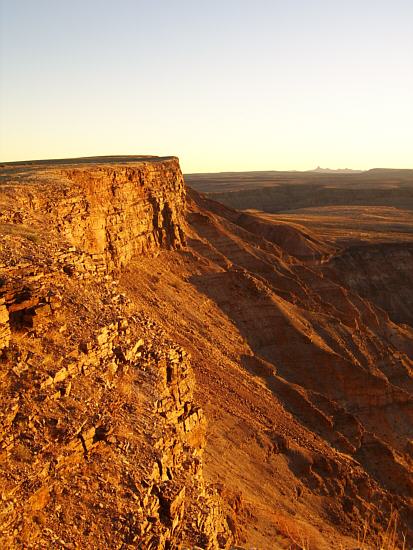
Due to the large distances one must consider oneself reflect on always careful, what is to do in the next village and which activities could be combined.
At the end of the day still another special high-light stood on the program: Sunset at the Fish River Canyon.
It should be after the Grand Canyon in the USA the largest one.
But even if it is not, then the view during a short walk at its top edge and the lights during the sunset were overwhelming.
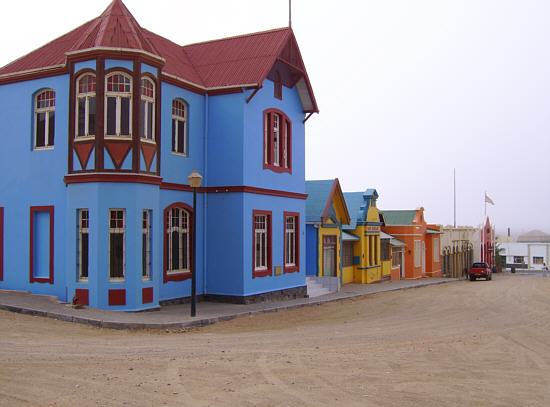 The day 4 guided us across the diamond restricted area to Lüderitz.
Diamonds? Diamonds!
No, a stepping out and collecting a few raw diamonds gather was strictly forbidden.
Unfortunately the fog covered up the city, so that from the multicolored houses only little was to be seen.
We stayed overnight on the Shark Island, which are connected with the mainland by a short dam.
On it is also one of the 4 lighthouses of Namibia
One can rent the old (beautiful) lighthouse even for overnight accomodation.
It's located beside the new (ugly) one, which is constructed from steel tubes.
The day 4 guided us across the diamond restricted area to Lüderitz.
Diamonds? Diamonds!
No, a stepping out and collecting a few raw diamonds gather was strictly forbidden.
Unfortunately the fog covered up the city, so that from the multicolored houses only little was to be seen.
We stayed overnight on the Shark Island, which are connected with the mainland by a short dam.
On it is also one of the 4 lighthouses of Namibia
One can rent the old (beautiful) lighthouse even for overnight accomodation.
It's located beside the new (ugly) one, which is constructed from steel tubes.
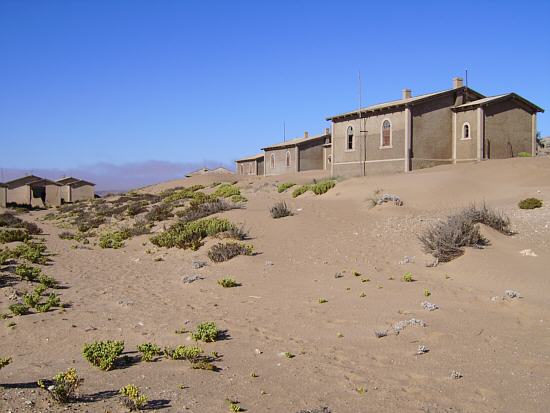 On the rocks of Lüderitz began the short, but until today visible influence of Germany on this region.
And after one discovered at the railway line from Lüderitz to Keetmanshoop that the desert sand was littered with diamonds, a not known diamond fever set in.
Whole cities were established and purged again, like the ghost town Kolmanskop, which we regarded at the day 5.
The German "guest performance" ended during the 1st World War in two internment camps.
One camp was located close to the small city Aus (the German word for end/finish) - a name, which actually says everything.
On the rocks of Lüderitz began the short, but until today visible influence of Germany on this region.
And after one discovered at the railway line from Lüderitz to Keetmanshoop that the desert sand was littered with diamonds, a not known diamond fever set in.
Whole cities were established and purged again, like the ghost town Kolmanskop, which we regarded at the day 5.
The German "guest performance" ended during the 1st World War in two internment camps.
One camp was located close to the small city Aus (the German word for end/finish) - a name, which actually says everything.
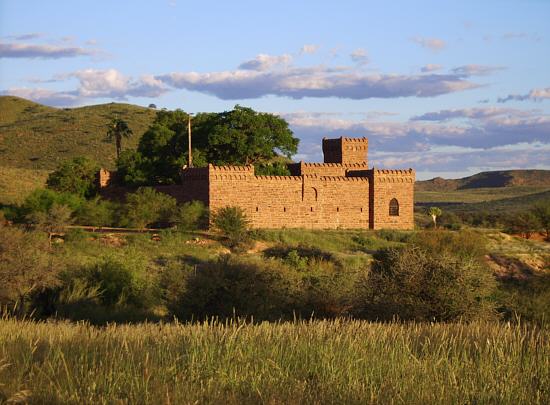
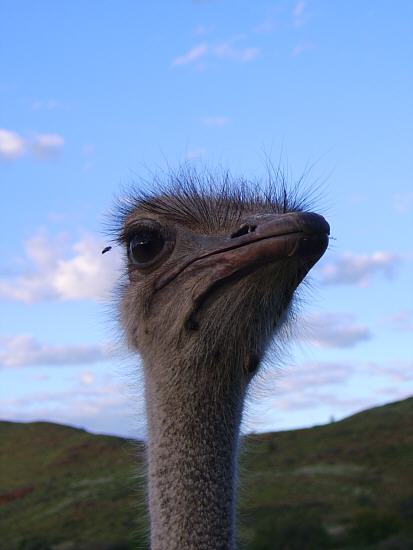 Continued to be to the castle Dusiwib, that normaly lies in the middle of the dry areas.
There it lies still, but since it had long rained two weeks before, one was to be seen only sumptuous green.
Jochen, ethnic German farmer close to the castle, said that he would have now fodder for three (!) years.
How it looks otherwise?
On his farm of 6000 hectars (60 km², small for Namibia) he and his children breed cattle, goats and horses.
In addition they hold themselves a few ostriches.
Note: Normally the farms in Namibia covers 10000 up to 15000 hectars (100 up to 150 km²).
Continued to be to the castle Dusiwib, that normaly lies in the middle of the dry areas.
There it lies still, but since it had long rained two weeks before, one was to be seen only sumptuous green.
Jochen, ethnic German farmer close to the castle, said that he would have now fodder for three (!) years.
How it looks otherwise?
On his farm of 6000 hectars (60 km², small for Namibia) he and his children breed cattle, goats and horses.
In addition they hold themselves a few ostriches.
Note: Normally the farms in Namibia covers 10000 up to 15000 hectars (100 up to 150 km²).
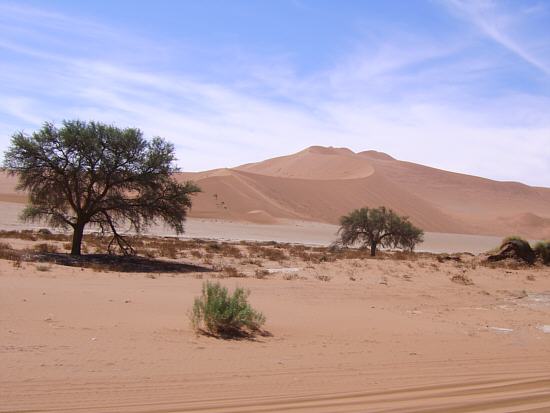
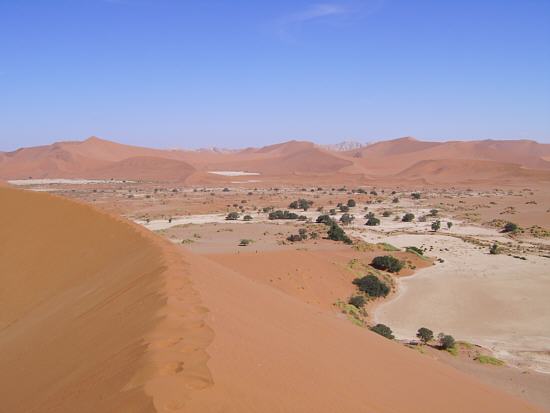 The day 6 brought us at least to my goal: the dunes by Sossusvlei.
I knew some pictures, but these giants once to see and to climb, was already an overwhelming experience.
Particularly in the late afternoon nearly with each step the views and particularly the colors change.
The day 6 brought us at least to my goal: the dunes by Sossusvlei.
I knew some pictures, but these giants once to see and to climb, was already an overwhelming experience.
Particularly in the late afternoon nearly with each step the views and particularly the colors change.
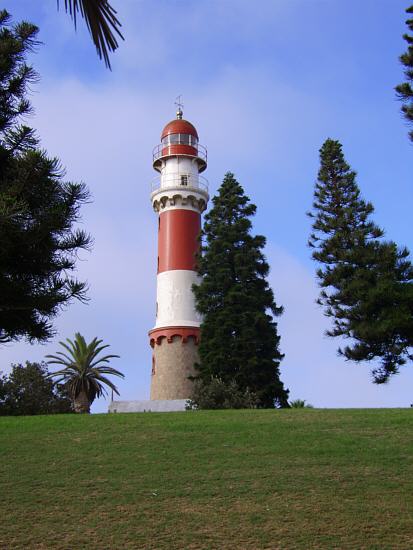
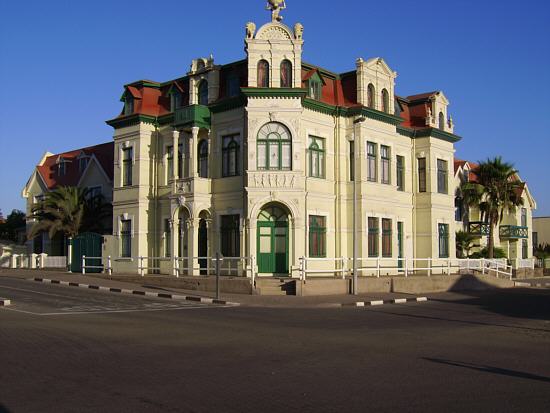 We wanted to observe at the day 7 close to Walvis Bay actually flamingos and pelicans.
But the birds had gone on a trip. Thus it continued to go quite fast to Swakopmund.
In this nice small and planted city with its lighthouse one forgets fast that ring around is only the Namib desert.
We wanted to observe at the day 7 close to Walvis Bay actually flamingos and pelicans.
But the birds had gone on a trip. Thus it continued to go quite fast to Swakopmund.
In this nice small and planted city with its lighthouse one forgets fast that ring around is only the Namib desert.
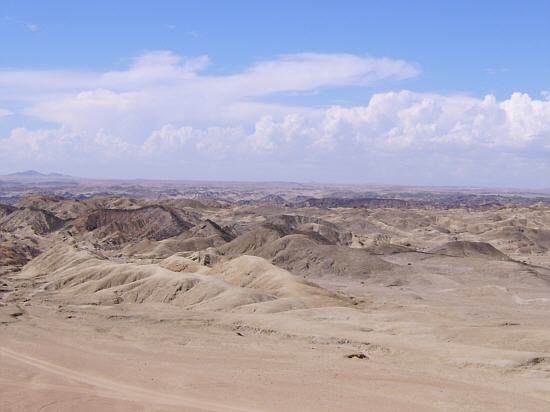 The day 8 was actually intended for strolling in Swakopmund.
But all members of our group wanted to undertake a travel into the desert.
Who thinks now that there is no life, who errs.
In addition this part of the Namib desert looks completely differently than the area around Sossusvlei.
It consists nearly only of rocky hills. The whole life is mainly dependent on the fog by the Atlantic.
And this one comes punctually each morning.
The day 8 was actually intended for strolling in Swakopmund.
But all members of our group wanted to undertake a travel into the desert.
Who thinks now that there is no life, who errs.
In addition this part of the Namib desert looks completely differently than the area around Sossusvlei.
It consists nearly only of rocky hills. The whole life is mainly dependent on the fog by the Atlantic.
And this one comes punctually each morning.
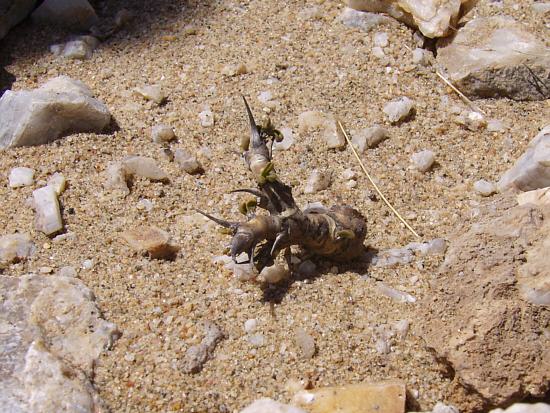
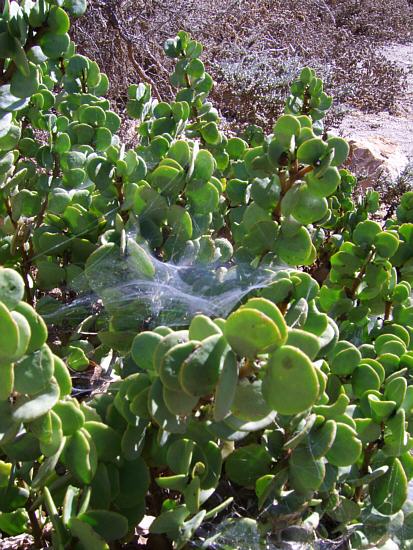 Harald, an ethnic German native one, showed us during a travel with a jeep into the desert lots of plants growing there and described also their effects.
The only a few centimeters large "San-candle" in the left photo for example by combustion dispel mosquitoes.
And the thick sheets of the in the right photo seeing "plate leaf plant" are be able to serve as water replacement.
Harald, an ethnic German native one, showed us during a travel with a jeep into the desert lots of plants growing there and described also their effects.
The only a few centimeters large "San-candle" in the left photo for example by combustion dispel mosquitoes.
And the thick sheets of the in the right photo seeing "plate leaf plant" are be able to serve as water replacement.
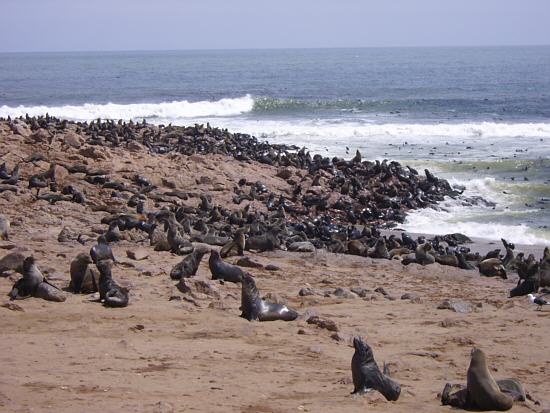
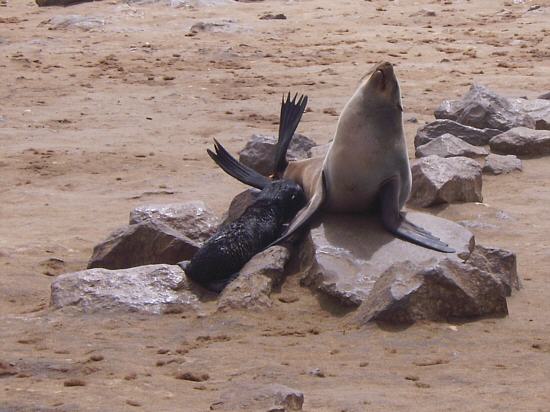 The day 9 became first loud and not straight probably-smelling, then however quiet and romantically.
First we drove to the Cape Cross, at which a seal colony settled.
The cape received it's name from the Portuguese Diogo Cão, who sailed along the African coast in 1486 up to this point, set up here a stone cross and sailed back.
The day 9 became first loud and not straight probably-smelling, then however quiet and romantically.
First we drove to the Cape Cross, at which a seal colony settled.
The cape received it's name from the Portuguese Diogo Cão, who sailed along the African coast in 1486 up to this point, set up here a stone cross and sailed back.
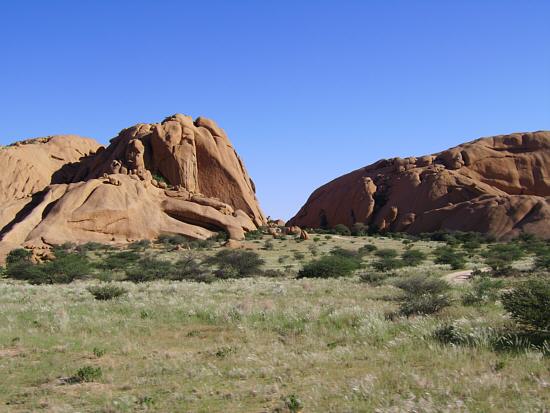
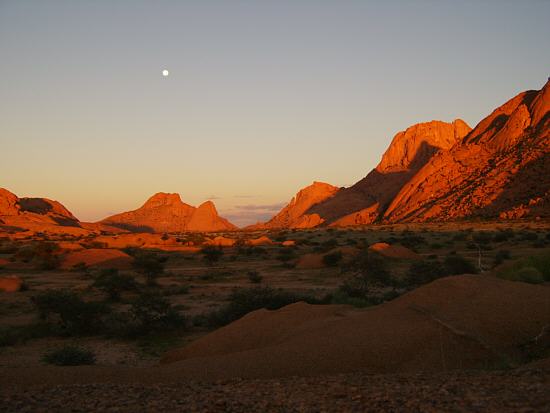 For us however it goes further to the Spitzkoppe, a mountain range, which is not too high but which however rises up abruptly out of the otherwise flat terrain.
Electricity does not give it, but however spectacular sundowns and sunsets with skies littered with stars between them.
For us however it goes further to the Spitzkoppe, a mountain range, which is not too high but which however rises up abruptly out of the otherwise flat terrain.
Electricity does not give it, but however spectacular sundowns and sunsets with skies littered with stars between them.
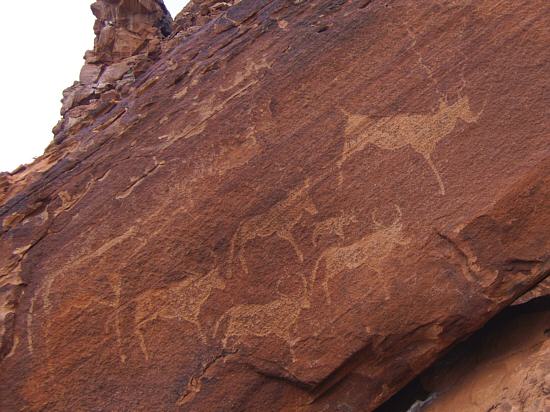
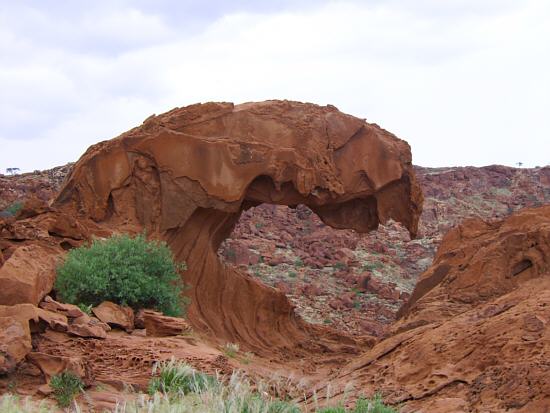 One of the areas close to Khorixas, in which are rock engravings of the already nearly completely displaced San to be found, was among other things a goal of the days 10 and 11.
Unfortunately some the drawings were damaged by tourists, so that there only led hikes can be undertaken.
One of the areas close to Khorixas, in which are rock engravings of the already nearly completely displaced San to be found, was among other things a goal of the days 10 and 11.
Unfortunately some the drawings were damaged by tourists, so that there only led hikes can be undertaken.
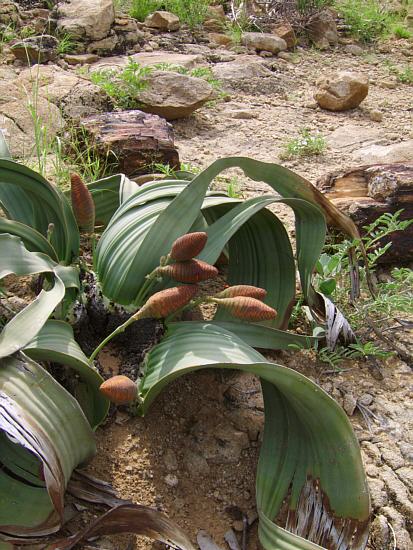
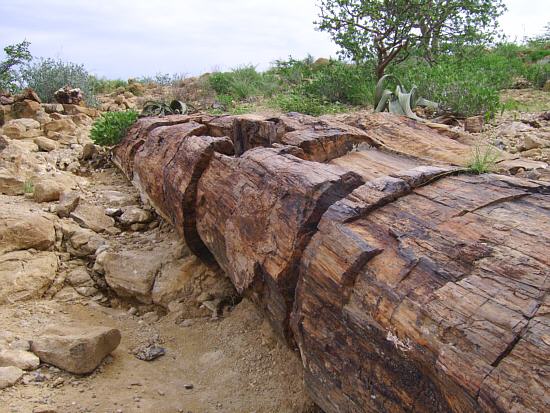 In many places in the fog area along the Atlantic coast a special plant can be discovered, the Welwitschia mirabilis.We discovered them in the Namib desert near by Swakopmund and also at the petrified forest close to Khorixas
In the left photo you can see the unfortunately already withered Welwitschia mirabilis.
On the thickest trunk in the petrified forest, which can be seen on the right photo even still the tree-rings are recognizable.
In many places in the fog area along the Atlantic coast a special plant can be discovered, the Welwitschia mirabilis.We discovered them in the Namib desert near by Swakopmund and also at the petrified forest close to Khorixas
In the left photo you can see the unfortunately already withered Welwitschia mirabilis.
On the thickest trunk in the petrified forest, which can be seen on the right photo even still the tree-rings are recognizable.
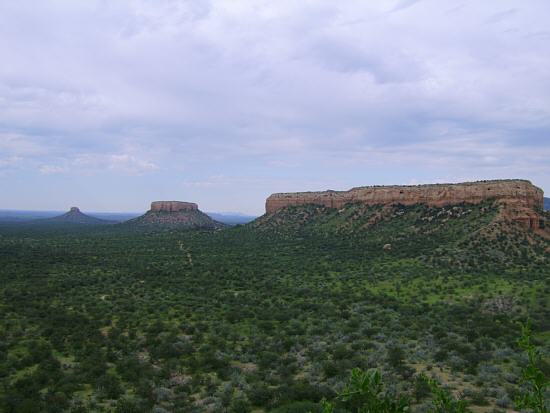
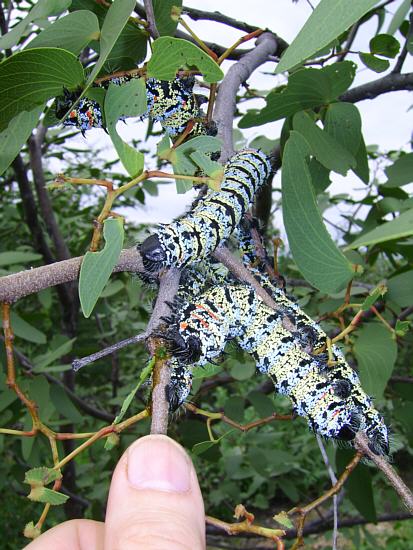 A further want-coming stop we made at the day 12 at the Vingerklip, from which one has a marvelous view into the valley of the river Ugab with its mesas.
On the footpath there I discovered finally also the Mopane worms eating in the Mopane trees.
Two days later also still the opportunity should be offered to be able to eat this delicacy deep-fried.
Result: It taste nutty, it's owing to the feets a little bit spiny, however it will not become my favourite dish.
A further want-coming stop we made at the day 12 at the Vingerklip, from which one has a marvelous view into the valley of the river Ugab with its mesas.
On the footpath there I discovered finally also the Mopane worms eating in the Mopane trees.
Two days later also still the opportunity should be offered to be able to eat this delicacy deep-fried.
Result: It taste nutty, it's owing to the feets a little bit spiny, however it will not become my favourite dish.
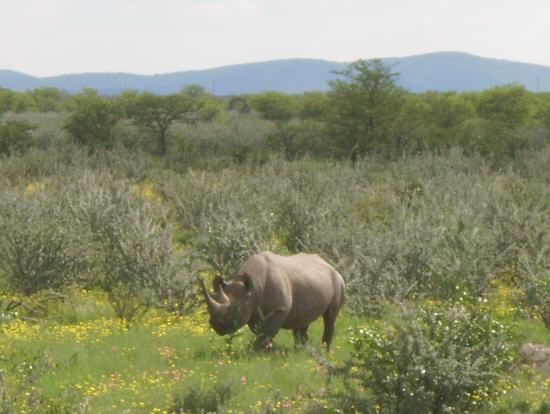 The entire day 13 was reserved for three important things: animals observe, animals observe and again animals observe.
We assumed that this would have to be simple in the well-known and largest national park of Namibia, the Ethosha National Park.
It would have also been, even if it had not a few weeks before strongly rained.
To our luck we already discovered during our travel into the park in the afternoon before a grazing black rhinoceros - the only one we should remain.
However it saw out somehow peculiar on the flower meadow.
The entire day 13 was reserved for three important things: animals observe, animals observe and again animals observe.
We assumed that this would have to be simple in the well-known and largest national park of Namibia, the Ethosha National Park.
It would have also been, even if it had not a few weeks before strongly rained.
To our luck we already discovered during our travel into the park in the afternoon before a grazing black rhinoceros - the only one we should remain.
However it saw out somehow peculiar on the flower meadow.
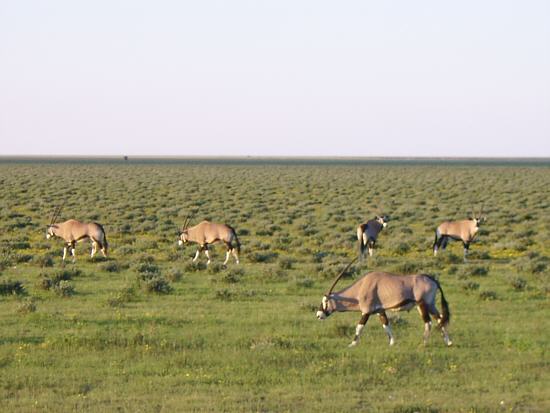
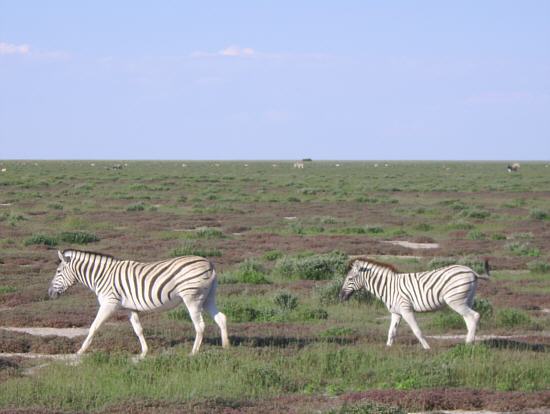 Therefore the safari became despite the good outlook from the high bus by the many strongly foliate trees and the high grass to a search play.
Making it more difficult was added that for the protection of the animals and the plants the ways in the Ethosha National Park will may not leave - the road network is actually close enough.
Therefore the safari became despite the good outlook from the high bus by the many strongly foliate trees and the high grass to a search play.
Making it more difficult was added that for the protection of the animals and the plants the ways in the Ethosha National Park will may not leave - the road network is actually close enough.
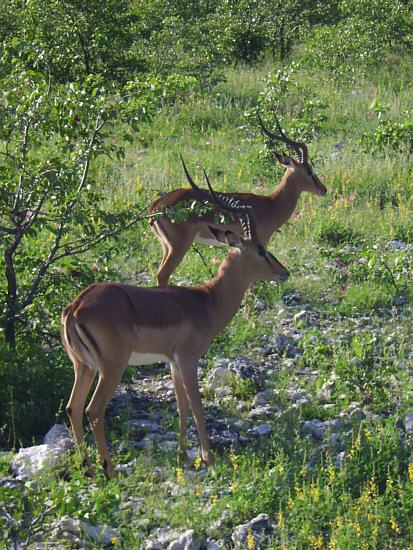
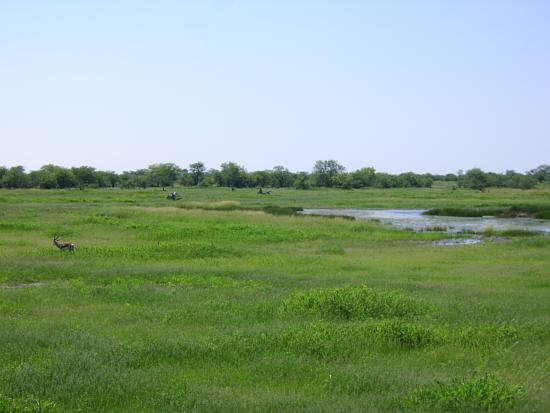 On the far surfaces repeatedly enormous herds with Springboks, wildebeests, oryx (photo on the left of above) and Hartmann-zebras (photo on the top right) were to constitute.
Late on afternoon we discovered among other things also giraffes and impalas (photo left).
At the water holes, which are particularly in the early morning and evening hours a goal of many animals (and concomitantly tourists), very little game appeared was to locate.
This was only too good to understand, where there were nevertheless now everywhere larger and small water puddles.
On the far surfaces repeatedly enormous herds with Springboks, wildebeests, oryx (photo on the left of above) and Hartmann-zebras (photo on the top right) were to constitute.
Late on afternoon we discovered among other things also giraffes and impalas (photo left).
At the water holes, which are particularly in the early morning and evening hours a goal of many animals (and concomitantly tourists), very little game appeared was to locate.
This was only too good to understand, where there were nevertheless now everywhere larger and small water puddles.
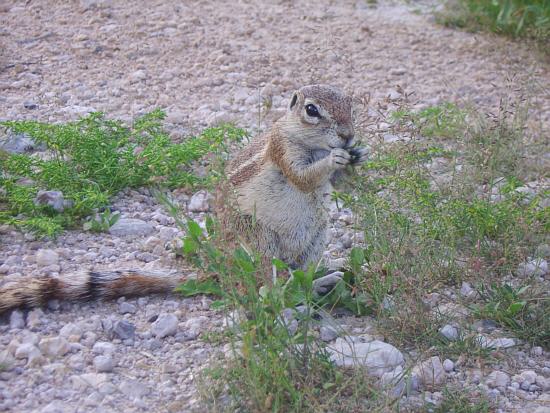 But also in the evening in the camp observing animals did not stop.
This time they were however smaller and more trusting: ground squirrel.
At night nearly tamely jackals ran by the camp and emptied out each dustbin, in which eatables could be assumed.
But also in the evening in the camp observing animals did not stop.
This time they were however smaller and more trusting: ground squirrel.
At night nearly tamely jackals ran by the camp and emptied out each dustbin, in which eatables could be assumed.
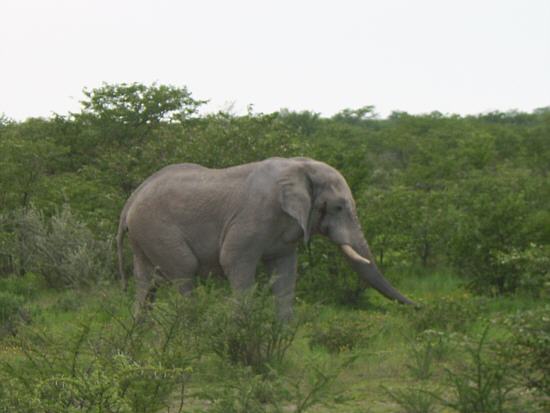 We were consoled at the day 14 when driving out of the park.
To our joy we discovered a small pride of lions that after an extensive zebra breakfast had established itself under a tree something off the road and snoozed.
And one of the alleged altogether 2500 elephants also still ran us in cameras, after we discovered an other one at the day before, which remained in the shade behind a tree.
We were consoled at the day 14 when driving out of the park.
To our joy we discovered a small pride of lions that after an extensive zebra breakfast had established itself under a tree something off the road and snoozed.
And one of the alleged altogether 2500 elephants also still ran us in cameras, after we discovered an other one at the day before, which remained in the shade behind a tree.
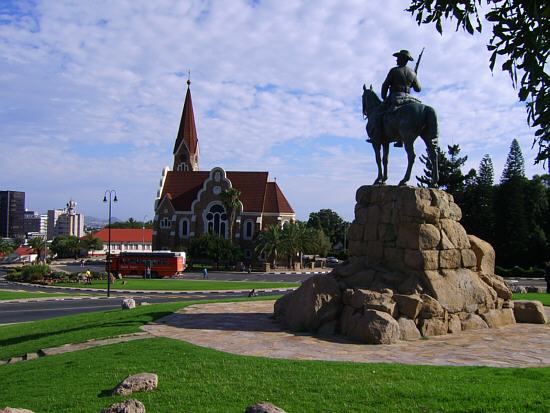 After a long travel back to Windhoek we visited at the day 15 the capital.
For me as German it was however something oppressing to see among other things the monument for the German colonial force.
After a long travel back to Windhoek we visited at the day 15 the capital.
For me as German it was however something oppressing to see among other things the monument for the German colonial force.
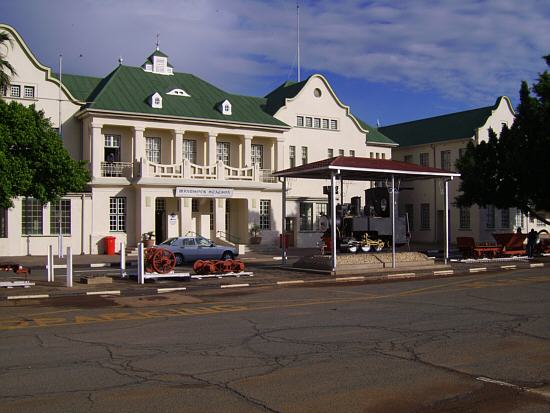 Consider, how many humans died by the claims to power on both sides and how strongly the country was changed.
More pleasing it was already to regard the active driving in the city.
The people of the railway station e.g. are "very busy".
Differently one can not interpret the timetable with 14 trains each week, sometimes even three on one day.
Consider, how many humans died by the claims to power on both sides and how strongly the country was changed.
More pleasing it was already to regard the active driving in the city.
The people of the railway station e.g. are "very busy".
Differently one can not interpret the timetable with 14 trains each week, sometimes even three on one day.
Journeys with Rotel Tours ![]()
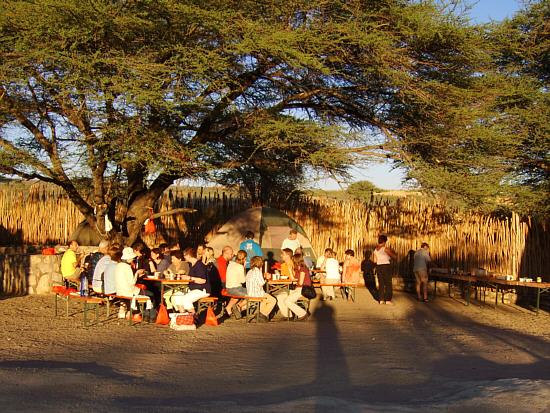 Now and then I am asked, as it is to travel with Rotel Tours.
Whereupon I can always only answer: Inimitably! I know so far no travel organizer, with whom the beds and the kitchen are always ready.
Straight one if one the withdrawn tourist ways abandoned would like, is this form inestimable importance.
And which hotel can grant the comfort to take the breakfast and dinner in the open air, or as in the left photo under a camel thorn tree.
If should be thereby nevertheless times damp weather, then also fast a tarpaulin can be stretched.
Now and then I am asked, as it is to travel with Rotel Tours.
Whereupon I can always only answer: Inimitably! I know so far no travel organizer, with whom the beds and the kitchen are always ready.
Straight one if one the withdrawn tourist ways abandoned would like, is this form inestimable importance.
And which hotel can grant the comfort to take the breakfast and dinner in the open air, or as in the left photo under a camel thorn tree.
If should be thereby nevertheless times damp weather, then also fast a tarpaulin can be stretched.
The beds are actually a chapter for itself.
Often we were during our travel the goal of curious views.
The trailer with its three window rows (and sleep places) looks somewhat unusual.
But who got accustomed once to it, in one approximately 80 cm width, 80 cm high and sufficiently long bunk with window to sleep, would not like to missen any longer this kind of the travel.
For couples in each case some double cabs are available, otherwise there are single cabs.
With the next journey I must make at the next time a few photos of the construction and the inside of the sleeping car.
Perhaps also other people are encouraged to thus travel and sleep.
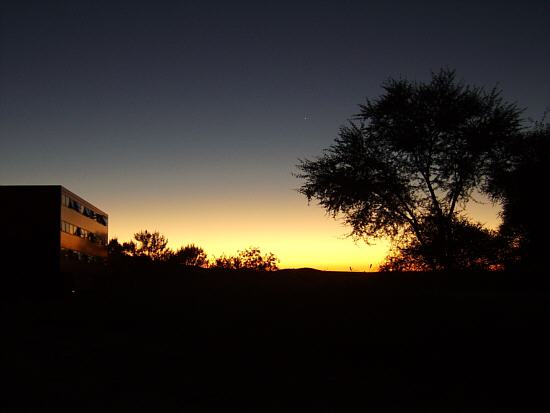 In addition one becomes acquainted with fast different people, which is not sure in a hotel or a holiday house.
Thus (nearly) everyone accesses also, if it goes at the mounting and disassembly of the tent for the sleeping car or to preparing the meals or the others approximately activities which can be settled around the bus.
And who already times heard at night a lion roar, while one lies secure in bed, who can probably understand my enthusiasm for these nature near kind of the travel.
In addition one becomes acquainted with fast different people, which is not sure in a hotel or a holiday house.
Thus (nearly) everyone accesses also, if it goes at the mounting and disassembly of the tent for the sleeping car or to preparing the meals or the others approximately activities which can be settled around the bus.
And who already times heard at night a lion roar, while one lies secure in bed, who can probably understand my enthusiasm for these nature near kind of the travel.
 PS. The term Sandsation in the headline was coined by an event, which take place since 2003 every year near the railway main station (Hauptbahnhof) in Berlin/Germany.
There will be crafted in July and August for some weaks large sand sculptures, which also can be visited during the emergence and thereafter still some time.
PS. The term Sandsation in the headline was coined by an event, which take place since 2003 every year near the railway main station (Hauptbahnhof) in Berlin/Germany.
There will be crafted in July and August for some weaks large sand sculptures, which also can be visited during the emergence and thereafter still some time.
In 2007 the event stood under the slogan "Welcome to Paradise.
The mouse on the cheese mountain was for example about 5 m largely.
This event take place in the year 2008 from 8.6. - 3.8.
If you should be at this time in Berlin, I can recommend the attendance to you.
73/72 de Ingo, DK3RED - Don't forget: the fun is the power!